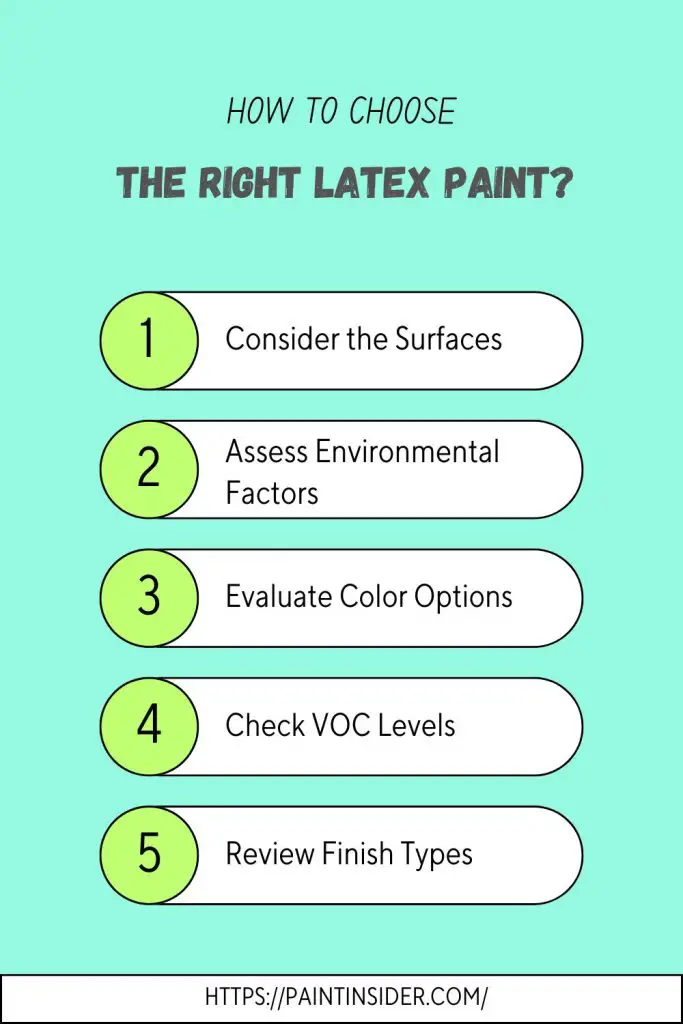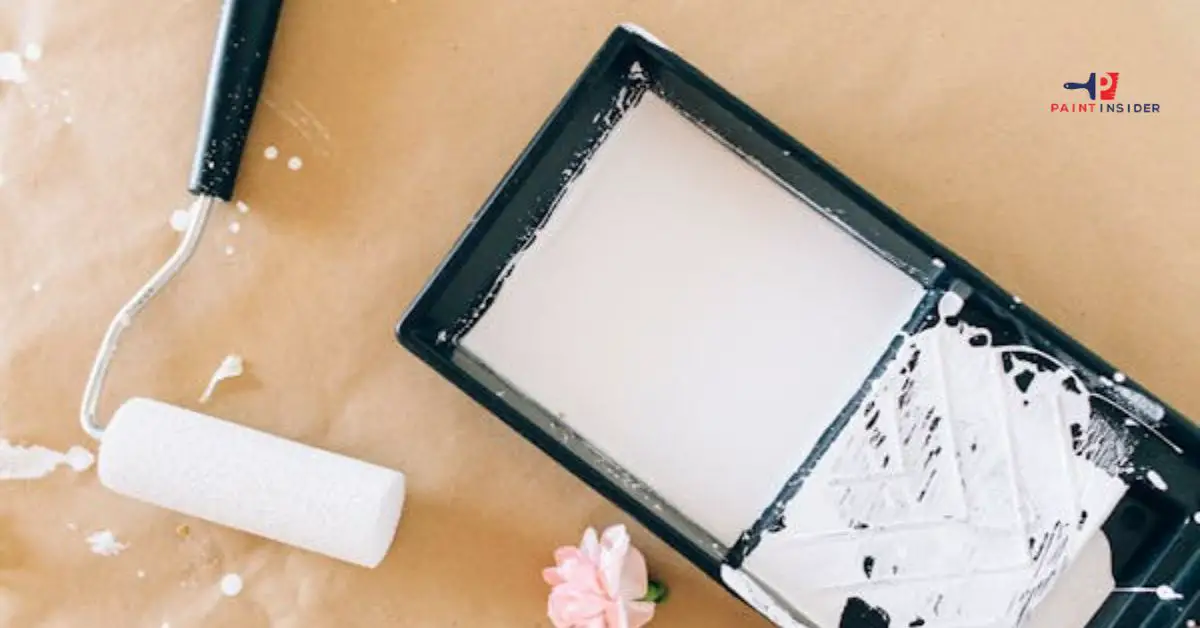From this blog, you will learn the uses of latex paint, a versatile, water-based paint perfect for indoor and outdoor applications. Ideal for walls, ceilings, furniture, and more, learn how latex paint offers easy application, quick drying, and durable, long-lasting results.
What is Latex in Paint?
Latex paint is a synthetic polymer emulsion that acts as the paint’s binder, which helps the particles stick together and to the surface. Despite the name, latex paint doesn’t contain natural latex from rubber, it’s made with acrylic or vinyl resins. These resins give the paint flexibility, durability and resistance to peeling and fading, that’s why latex paint is great for interior and exterior use.
Latex paint is water based so it has some great benefits: it’s easy to clean up with water, low odor, low VOCs and dries fast.
Types of Latex Paints Available
Acrylic Latex Paint: Acrylic latex paint stands out for its versatility, making it a go-to choice for both DIY enthusiasts and professional painters alike. Unlike traditional oil-based paints, acrylic latex paint is water-based, which means it dries quickly and cleans up easily with soap and water. This makes it perfect for a variety of applications, ranging from interior walls to exterior surfaces. Whether you’re revamping your living room or giving new life to your porch furniture, this type of paint offers exceptional adhesion and a durable finish that can withstand the test of time.
Vinyl Acrylic Latex Paint: Vinyl acrylic latex paint, a popular choice among homeowners and decorators alike, combines the best features of both vinyl and acrylic resins. This unique blend offers impressive adhesion, flexibility, and durability, making it ideal for a wide range of applications from interior walls to exterior surfaces. Its ability to withstand temperature fluctuations and resist fading means that your chosen color stays vibrant longer, even when exposed to harsh sunlight.
Alkyd-Modified Latex Paint: Alkyd-modified latex paint combines the best characteristics of both alkyd and latex formulations, making it an ideal choice for various painting projects. This innovative hybrid offers the ease of cleanup associated with water-based paints while delivering the durability and sleek finish often linked to oil-based alternatives. Homeowners can use alkyd-modified latex paint for everything from interior walls to exterior trim, providing a versatile option that stands up against challenging weather conditions without compromising on aesthetics.
Enamel Latex Paint: Enamel latex paint stands out in the world of coatings for its durability and versatility, making it a favorite among DIY enthusiasts and professionals alike. What sets this paint apart is its unique formulation that combines the best qualities of acrylics with traditional oil-based enamels. This means you can enjoy the easy cleanup and quick drying times of latex while still achieving the hard, glossy finish typically associated with enamel paints. Whether you’re refreshing your kitchen cabinets or adding a touch of color to your home’s exterior trim, enamel latex paint delivers excellent adhesion and resistance to wear.
Common Uses for Latex Paint
Interior Walls: One of the most popular uses for latex paint is on interior walls. Its easy cleanup and low odor make it an ideal choice for home improvement projects, allowing you to refresh your space without overwhelming fumes lingering in the air. Plus, with a wide range of colors available, transforming a dull room into a vibrant sanctuary is just a few brush strokes away.
Trim and Molding: Latex paint excels at highlighting trim and molding due to its smooth finish. It dries quickly, enabling you to apply multiple coats in a single day without extensive waiting periods, making your renovation projects more efficient.
Furniture Restoration: Latex paint isn’t just for walls; it’s also perfect for giving new life to old furniture. Whether you’re revamping a wooden chair or updating an outdated dresser, latex provides excellent coverage and durability. The flexibility of this paint means it can adapt well to various surfaces while maintaining its finish over time.
Exterior Surfaces: Many homeowners opt for latex paint to enhance their home’s exterior as it’s resistant to fading and cracking from UV exposure. Additionally, its breathability allows moisture trapped underneath surfaces to escape, reducing the risk of blisters in painted areas. Utilizing high-quality latex paints on exteriors can significantly extend the lifespan of your home’s facade while keeping maintenance manageable over time.
Using latex paint opens up several opportunities that elevate both aesthetic appeal and functionality in any project you undertake!
Advantages of Using Latex Paint
Versatility in Application: Enamel latex paint is renowned for its adaptability across various surfaces, including wood, metal, and masonry. This makes it an excellent choice for both indoor and outdoor projects, allowing you to achieve a consistent finish no matter the medium.
Durability Meets Ease of Use: One of the key advantages of using latex paint lies in its resilience. It withstands wear and tear remarkably well compared to traditional oil-based paints while offering a smoother application process that even DIY novices can master. Plus, cleanup is a breeze with just soap and water!
Eco-Friendly Options: Today’s enamel latex paints come in environmentally friendly formulations that emit lower levels of volatile organic compounds (VOCs). This not only benefits your health but also contributes positively to the environment an appealing aspect for eco-conscious consumers looking to beautify their spaces guilt-free.
Disadvantages of Latex Paint
Drying Time Can Be a Double-Edged Sword: While latex paint dries quickly, this can be disadvantageous for those looking for extended working time. For intricate projects that require meticulous brushwork, the fast-drying properties can lead to issues such as visible brush strokes or lap marks, making it challenging to achieve a smooth finish on larger surfaces.
Vulnerability to Water Damage: Though latex paint is water-resistant after drying, it remains susceptible during the application phase. If exposed to moisture before it’s fully set, it can easily wash away or create blemishes on the final surface. This makes timing critical under humid conditions or when dealing with outdoor projects.
Limited Adhesion on Certain Surfaces: Latex paint generally requires primed surfaces for optimal adhesion. On glossy materials like metal or previously painted high-gloss surfaces, additional steps may be necessary for instance, sanding and priming adding significant labor and cost before you even get started painting. This could deter DIY enthusiasts from jumping into spontaneous projects where prep time isn’t factored in.
How to Choose the Right Latex Paint?
To choose the right latex paint follow these few steps which are given below.

- Consider the Surfaces: Start by identifying what surfaces you plan to paint. Latex paint is versatile and ideal for walls, ceilings and even furniture. However, some finishes may work better on specific materials, check whether you need a matte finish for textured walls or a glossy option for trim.
- Assess Environmental Factors: Think about where your painted item will be located. If it’s an exterior project, opt for latex paints formulated to withstand weather variations. For high-humidity areas like bathrooms or kitchens, choose mildew-resistant latex paints that ensure longevity and easier maintenance.
- Evaluate Color Options: The right color can dramatically transform a space. Look at swatches in various lighting conditions before making your final selection; natural and artificial light can significantly alter how colors appear.
- Check VOC Levels: Volatile organic compounds (VOCs) released during painting can impact indoor air quality. Opting for low-VOC or zero-VOC latex paints not only benefits health but also contributes to environmental sustainability without compromising color choices or durability.
- Review Finish Types: Understand the different types of finishes available flat, eggshell, satin, semi-gloss, and gloss. Each serves unique purposes from aesthetics to washability. Your finish choice should align with both functional needs and personal style preferences.
Application Techniques for Latex Paint
- Preparation is Key: Start by cleaning the surface you intend to paint. Remove dust, dirt, and grease to ensure a smooth finish. If necessary, patch up any holes or imperfections with filler and sand down rough areas.
- Gather these necessary tools for latex paint: Sandpaper, Drop cloths or plastic sheets, Paint rollers, A paint bucket, Touch-up brush.
- Prime When Needed: If you’re painting over a dark color or porous surfaces like drywall, apply a primer first. This step can enhance adhesion and provide a more vibrant finish.
- Mix It Up: Stir your latex paint thoroughly before application to ensure uniform color and consistency. For best results, pour the paint into a tray for easy access while using a roller.
- Start Painting! Use long strokes with your brush or roller; if using a spray gun, maintain an even distance from the surface to prevent dripping. To achieve that professional look and monitor how much paint is being applied it’s better to do multiple thin layers than one thick coat.
- Don’t Forget Ventilation: Ensure proper airflow in your workspace as latex paints can still emit vapors during application. Open windows and use fans if available so that fumes dissipate quickly.
These techniques not only help in achieving flawless results but also make the entire process more enjoyable! Whether you’re giving life to old furniture or refreshing interior walls, mastering these methods will turn what might seem daunting into a creative adventure.
Environmental Impact of Latex Paint
Latex paint, commonly used for walls and ceilings, boasts a myriad of colors and finishes, but its environmental impact is often overlooked. Made primarily from water and synthetic polymers derived from petroleum, the production process alone results in significant carbon emissions. Fortunately, it emits fewer volatile organic compounds (VOCs) compared to oil-based paints, making it a healthier option for indoor air quality. Yet, this doesn’t entirely absolve latex paint from environmental scrutiny; improper disposal can lead to pollution as the chemicals seep into soil and water systems.
Frequently asked questions (FAQs) about latex paint?
1: What surfaces can I use latex paint on?
You can use latex paint on a variety of surfaces including drywall, wood, metal, and masonry.
2: Is latex paint safe for indoor use?
Yes, latex paint is generally safe for indoor use as it has low levels of volatile organic compounds (VOCs), which means less harmful fumes.
3: Can I use latex paint outside?
Yes, there are specific types of exterior latex paints that are designed to withstand weather conditions.
4: How do I clean up after using latex paint?
Cleanup is simple; just wash brushes and tools with soap and water while the paint is still wet.
5: Does latex paint require a primer?
It depends on the surface. A primer may be needed for porous or uneven surfaces to ensure better adhesion and coverage.
6: How long does it take for latex paint to dry?
Latex paint typically dries to the touch within one hour but may take longer to fully cure depending on humidity and temperature.
7: Can I mix different brands of latex paint?
It’s not recommended because different brands may have varying formulations that could affect color and finish. Stick to the same brand when mixing.
Conclusion: Summary and Final Thoughts
Latex paint has proven to be a versatile choice for a variety of applications beyond just home walls. Its quick drying time and ease of cleanup make it an ideal option for DIY projects and touch-ups, appealing to both seasoned professionals and enthusiastic amateurs alike. Additionally, the wide range of finishes available allows consumers to achieve their desired aesthetic without sacrificing performance or durability.

